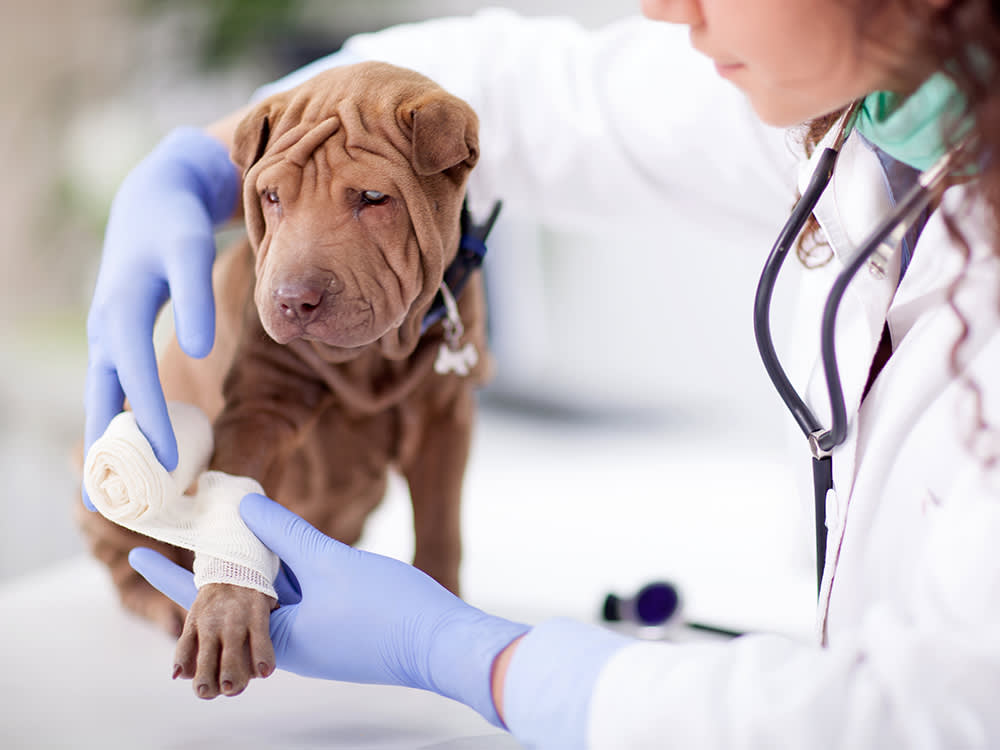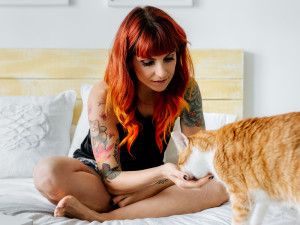Which Pet Insurance Company Is Right for You?
We compared the top insurers so you don’t have to.
You may have come across the viral “vet bills”opens in new tab TikTok videos, in which owners present their pets with vet bills and ask them to get a job. But pet care costs are no joke, amounting to nearly $17,000 in vet care in an average dog’s lifetime and over $13,000 for an average cat, according to estimates from American Pets Products. For pet parents who have elderly pets with medical issues, pet insurance is a no-brainer, as the bills can really add up. According to financial planning experts, picking the right insurance at the right time could save you thousands of dollars down the line and help you avoid unnecessary expenses.
Joanne Petrilli’s dog Sparky was diagnosed with gastric lymphoma later in life, which required thousands of dollars in treatments, tests, ultrasounds, and chemotherapy. She estimates it could have easily cost up to $20,000 in total. “It was a lot and I would have paid it regardless because I love my dogs,” she says. “But I was thankful that I had [insurance coverage] and people that don’t have pet insurance — I tell them ‘you’re crazy.’”
A growing number of pet insurance options makes it easier to plan for your pets’ medical bills and treatments. Most insurances don’t cover pre-existing conditions, so locking in a rate while your pet is young and healthy really pays off. Selecting the right company and plan depends on the age of your pet, their lifestyle, and how much you’re willing to spend. For example, not every plan includes dental cleaning. It also depends on if you’re mostly worried about accidents or preventative/wellness services and reimbursements. We’ve compiled an overview of some of the leading pet insurance providers and top considerations when choosing a coverage plan.
If the pet insurance terminology is throwing you off, most terms are similar to human insurance. An annual deductible means the amount you have to pay per year before the insurance coverage kicks in. And a monthly premium is the amount you pay each month to your pet insurer, which can vary from $20 to $70 or higher depending on how much coverage you want for which services.
How much do you spend on your pet per year?
Top insurance company stats
Lemonade
Lemonade,opens in new tab which is a publicly listed company, boasts quick reimbursement times promising to “get paid in minutes.” Their quotes and coverage are competitive, and there are discounts if you have multiple pets.
They offer a variety of add-on services, including preventative care like physical therapy and a dental package. They also have a helpful breakdown of the insurance lingo for the new pet owners.
At a glance:
Basic plan includes diagnostics, procedures, and medications
Customizable coverage options include vet visit fees or preventative wellness packages
Claims to have the “world record” for the fastest reimbursement payments
Special perks: live chat with medical experts on the Lemonade app; donates unclaimed premiums to animal welfare organizations; also offers discounts for multiple pets
Pets Best Pet Insurance
Pets Best was founded with the intent of ending economic euthanasia by giving pet parents the ability to afford unexpected veterinary costs. Pets Best is extremely customizable with super low rates and speedy claim-processing times. Discounts are available for families with multiple pets.
The Pets Best BestBenefit Accident and Illness Plans coverage includes illness, chronic conditions, cancer, hereditary conditions, congenital conditions, prosthetics, accidents, dental coverage, and more. Optional wellness plans cover vaccinations, deworming, microchipping, spay/neuter, and more, making them particularly ideal for puppies and kittens. The Pets Best app makes accessing benefit information and filing insurance claims easy, plus offers a 24/7 pet health helpline.
At a glance:
Offers customizable health plans for your pet’s specific needs
One annual deductible
No upper-age limits on accident and illness plans
Offers routine care coverage and an optional accident and illness exam fee coverage
Accident-only plan covers trauma, poisoning, and injury
Optional wellness plans cover vaccinations, deworming, microchipping, spay/neuter, teeth cleanings, and more
24/7 pet helpline
Trupanion
One of the biggest players in the pet insurance space, Trupanion insures over one million pets. They can pay claims directly to the vet at the time of check-out. “The ability to pay the veterinary invoice at the time of checkout directly to the veterinarian eliminates the need for pet owners to pay upfront and await reimbursement,” says Michael Nank, manager of public relations at Trupanion. “It also reduces the credit card fees that a hospital faces on a transaction.”
Trupanion doesn’t have a variety of plans, with all pets getting “one simple plan” that covers all injuries and illnesses. This plan covers 90 percent of veterinary costs for eligible claims once deductibles are met and has unlimited lifetime coverage, the company says.
At a glance:
Covers overs 90 percentopens in new tab of unexpected injuries and illnesses with a focus on medical needsopens in new tab
Offers “a lifetime per condition deductible” so you don’t have to to pay it again and only pay a deductible when your pet has a new condition
Wellness plans: limited wellness coverage opens in new tabon purpose
Special perks/offers: Trupanion has Exam Day Offers in certain statesopens in new tab, which provides immediate coverage and a $250 deductible
Healthy Paws
The Healthy Paws’s insurance plan is another provider that pays on your actual vet bill. It may be a better option for an older pet because it also covers “new injuries and illnesses, emergencies and genetic conditions.” Like most pet insurances, Healthy Paws doesn’t cover pre-existing conditions. It also doesn’t include preventative care like vaccinations, heartworm medication, or dental health care.
“When my Sparky was in and out of chemotherapy, Healthy Paws saved his life by paying for all of that; basically, they saved my dog’s life,” Petrilli says of her experience with the provider. She says the deductible amount is the most important criteria for her in deciding to stick with Healthy Paws for both of her pets.
At a glance:
Offers one plan that covers “new accidents and illnesses including injuries, cancer, genetic conditions, alternative and emergency care”
Has no maximum annual or lifetime payouts
Says most bills can be processed within two days via its mobile app
Does not cover preventative/wellness expenses, with some exceptionsopens in new tab
Special perks: Supports homeless pets through its Healthy Paws Foundationopens in new tab
Pumpkin
The New York-based startup offers a range of preventative care “add-ons” and recommendations based on your pet’s age and “lifestyle.” These preventative wellness packages would include blood tests, annual wellness exams, a limited number (two) vaccines for disease prevention and fecal tests for intestinal worms.
Pumpkin also covers services at any licensed vet, specialist or emergency clinic in the U.S. or Canada, so if you’re looking to travel with your pet, this may offer more flexibility.
At a glance:
Offers “extensive accident & illness coverage that doesn’t decline with age”
Has no “per condition deductible” required
Has no upper age limits for new enrollments or reduced coverage for aging pets
Has a Preventative Essentialsopens in new tab wellness package you can add to your insurance plan
Special perks: offers discounts for multiple pets
Comparing costs and coverage
I’ve entered information for my two-year-old Husky mix, and pretty much all of the insurance platforms had comparable rates to my current pet care plan at Nationwide, which has a great puppy package and does include coverage for some vaccines and routine tests.
Did Lemonade and Pumpkin have appealing user experience and fun tests to figure out the best coverage plan? Sure. But ultimately, it’s about the best value for your vet bills, so it may take the first month or two after your enrollment to see what is really covered well and if this particular company/plan really addresses your needs. The cost of your plan directly impacts your coverage. In terms of costs, there are four factors you need to pay attention to:
Annual Deductible
Reimbursement Percentage
Annual Coverage
Monthly Premium
Annual deductible
Your annual deductible is the amount you must pay out of pocket before your pet insurance kicks in. So, if your first vet bill of the year is $500 and your annual deductible is $500, you’ll have to pay the full $500. You’ll be reimbursed for a percentage of every other covered expense for the rest of the year.
Reimbursement package
Your reimbursement percentage is how much of your vet bill your provider will reimburse you for once you reach your deductible. So, if your vet bill is $1,000 and you have a reimbursement percentage of 80 percent, you’ll be reimbursed for $800 for covered treatment after you hit your deductible.
Annual coverage
Annual coverage is a cap on the amount you’ll receive in reimbursements from your insurance provider each year. Many pet insurance plans have unlimited annual coverage, so there is no cap. But some plans will only provide reimbursement up to a certain amount, such as $15,000 per year.
Monthly premium
Finally, your monthly premium is how much you pay each month to keep your plan active. Most pet parents want a low monthly premium because it won’t add as much to their monthly bills. Keep in mind that lower insurance premiums usually means lower rates of coverage. And premiums will increase over time as your pet ages, so understanding how much you can expect the premium to increase is an important factor in total cost.
The main takeaway is that the sooner you enroll your pet, the better. “We recommend that people enroll their pets as early in their life as possible,” Trupanion’s Michael Nank says. “The best way to avoid facing issues with pre-existing conditions, which are not covered by pet insurance providers, and to ensure maximum insurance coverage, is to enroll a pet in a policy while they are young and healthy.”














